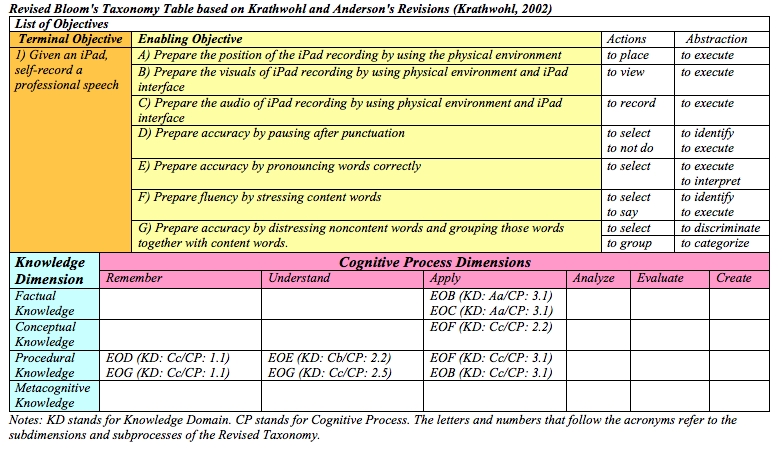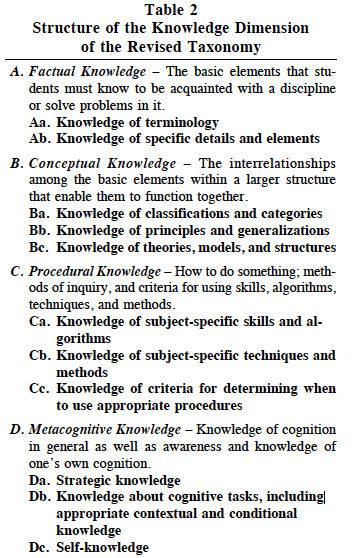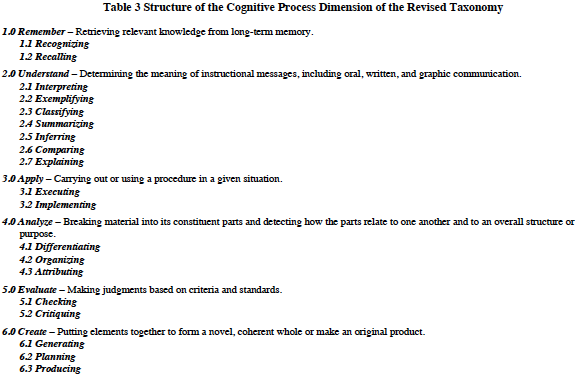- About
- Experience
- Web Development
- Instructional Work
- Skills
- Contact
The alignment chart summarizes the components of instruction: objectives, assessment and learning. This summary helps instructional designers to easily assess the coordination between the objectives, assessment and learning. This especially benefits the sequence of the 'Absorb', 'Do' and 'Connect' components.

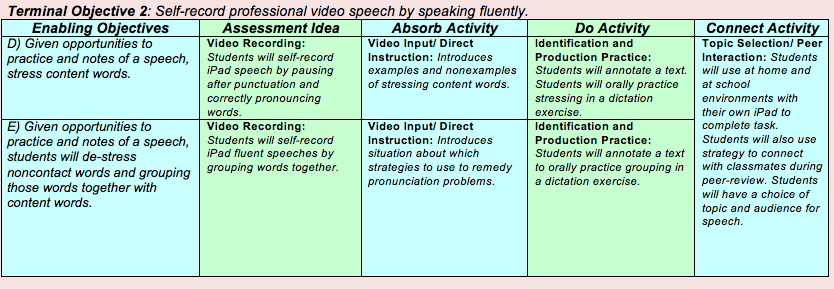

Summary of Instructional Types: This section presents instructional samples for two phases and one component of instruction. The 'absorb' is the learning phase. 'Do' is the practice phase. 'Connect' is the motivational, pragmatic or metacognitive component.
Summary of Instructional Content: Below are samples of 'Absorb', 'Do' and 'Connect' activities. For the 'Absorb', the Terminal 1 and Terminal 2 objectives are featured. The Terminal 1 'Absorb' presents a video of how to prepare the video camera. The Terminal 2 'Absorb' provides a Powerpoint Presentation on identifying content words for stressing. For the 'Do' phase, Terminal 2 is continued. The Terminal 2 'Do' presents an identification practice of content words. Students would complete this following the Terminal 2 'Absorb'. Last, the 'Connect' shows a self and peer evaluation of the production task. The production task follows the identification practice and application practice of Terminal 2.
This 'Absorb' provides the learning about preparing the positioning of the camera for the self-recorded video.
ENABLING OBJECTIVE A) Given an iPad app camera recorder, prepare position of iPad recording by using physical environment and iPad interface.
Universal Design Learning Connection: Representation Checkpoint 1.2 offers alternatives to auditory information. This example shows captions.
This video illustrates input for strategies students can take to position the camera. This method was select because it provides demonstration at the students' convenience.
This 'Do' provides the practice about locating words for stressing in a text.
ENABLLING OBJECTIVE D) Given opportunities to practice and notes of a speech, stress content words.
Universal Design Learning Connection: Action & Expression Checkpoint 5.1 Use multiple media for communication. This example shows visual manipulation.
Research-based Practice:Provide Practice found in Dean, C., Ross., E., Pitler., and Stone, B.J. (2012) Classroom Instruction That Works: Research-Based Strategies for Increasing Student Achievement, 2nd Edition. Alexandria, V.A.: ASCD.
This HTML page provides the practice for identifying content words and also for distinguishing stress in content words from noncontent words. This method was selected because it provides automatic checking with visual annotation.
This 'Connect' provides a self and peer evaluation for the assessment for Terminal 2.
ENABLLING OBJECTIVE D) Given opportunities to practice and notes of a speech, stress content words.
Universal Design Learning Connection: Engagement Checkpoint 9.3 Develop self reflection and assessment. This example shows an aid for students to assess their own progress.
Research-Based Practice: Rubrics for Self-Evaluation found in Brookhart, Susan. (2013) How to Create and Use Rubrics for Formative Assessment and Grading. Arlington, V.A.: Association for Supervision and Curriculum Development.
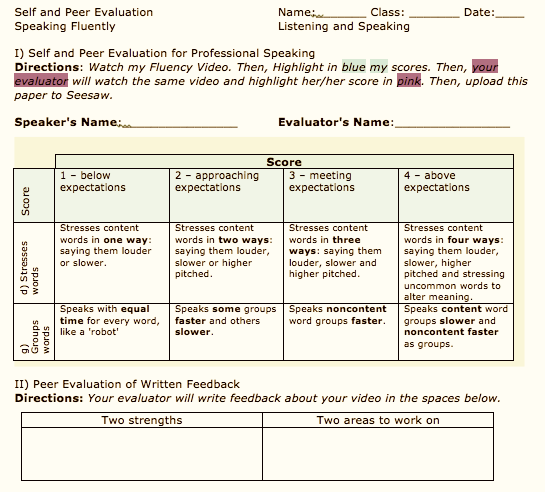
This template will be uploaded to the LMS Seesaw to accompany the evaluated video task. This was selected because learners are able to digitally annotate feedback and responses.
Explanation: This assessment is a performance-based summative assessemnt. A summative asssessment is the assessment that measures that knowledge and skills that students have acquired for the entire learning cycle. A performance-based of assessment usually showcases an authentic or concrete task, in which students demonstrate their knowledge and skills. This performance-based summative assessment combines the two previous assessments from the Terminal 2 and Terminal 3 objectives. For this assessment, students will make a speech by locating an information text that they wrote or found; this allows for creative design. Then, the students will use their iPads to make a self-record video. Students will apply their learning of video preparations, fluency and accuracy to self-record. This type was selected because performance-based assessments have presented convincing research. Likewise, the rubrics, which ultimately evaluate the assessment, provide descriptive and itemized criteria, which can be used as a formative checklist and measurement tool for students; they are also research-based practice. It also permits incorporation of all three terminal objectives.
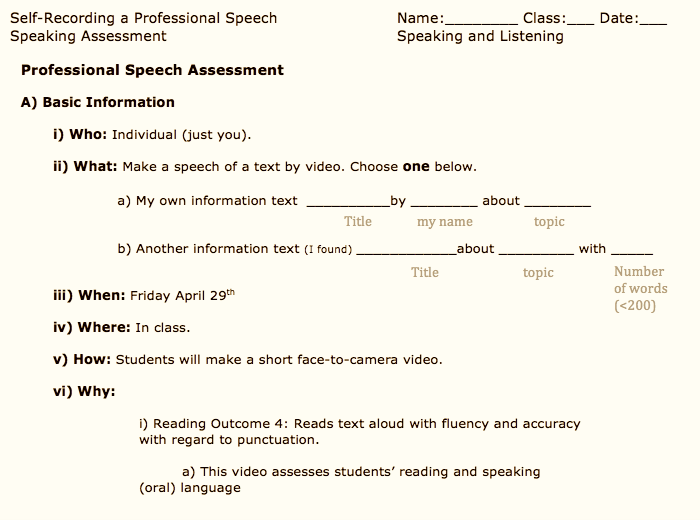
TERMINAL OBJECTIVE 1) Self-record professional video speech by using technology appropriately.
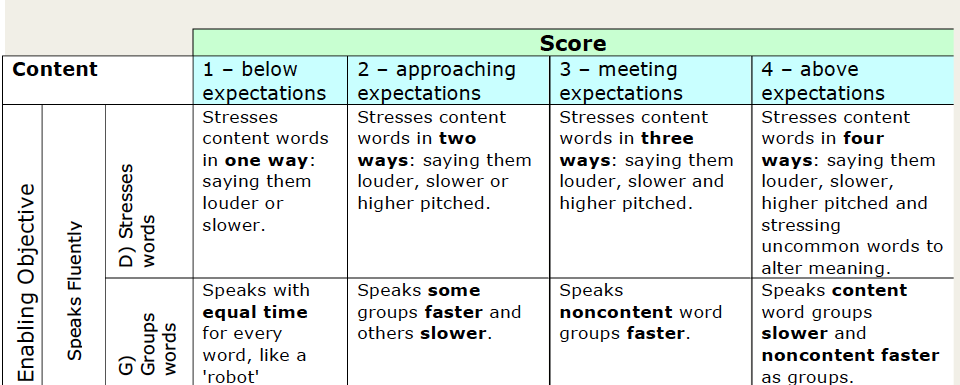
TERMINAL OBJECTIVE 2) Self-record professional video speech by speaking fluently.
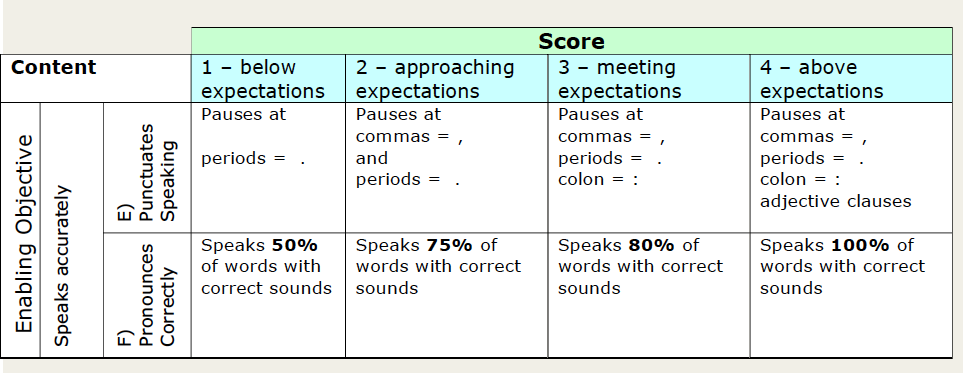
TERMINAL OBJECTIVE 3) Self-record professional video speech by speaking accurately.
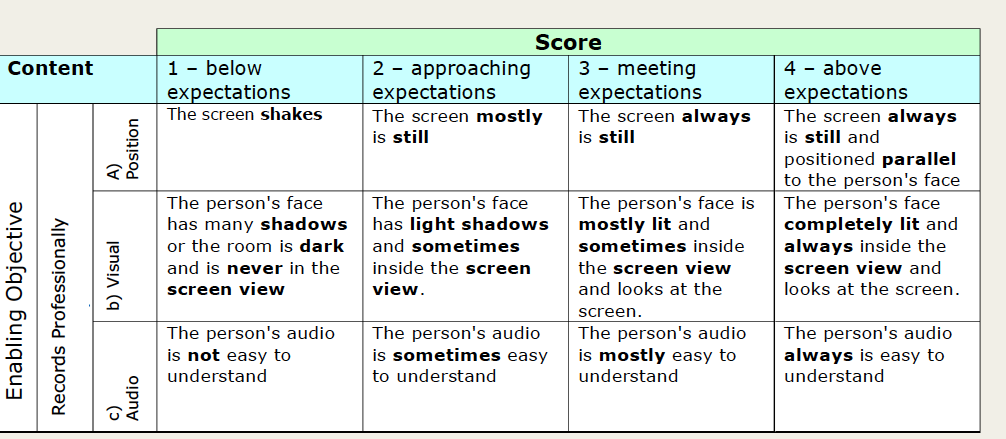
The general instructional process students follow occurs first, with a learning phase or an 'absorb' phase, second, with a practice phase or a 'do' phase, and third, with a 'connect' component or a engage, motivate or authenticate component. The 'Absorb' phase occurs for all three Terminal Objectives. For example, for Terminal Objective 2, students first learn to identify content words for stressing. Students, then, complete the 'Do' phase. For example, for Terminal Objective 2, students complete an identification practice for stressing words. Throughout the lessons, students engage with 'Connect' components. For example, at the beginning of the 'Do' phase of Terminal Objective 2, students ponder how pronunciation might be like a stereo speaker. Following 'Do', 'Absorb' and 'Connect', students complete an assessment. This assessment has students apply their knowledge and skills of identifying and producing stressed words. Students also collate their knowledge and skills to make videos that are clear visually and audibly.
This general instruction embodied significant research-based practices and Universal Design Learning Practices. For example, the summative assessment was a performance-based. Performance-based assessments are assessments by 'doing'. Wiggins and McTighe (2005) provides examples, such as oral presentation, dance, dramatic reading or debate. It may also account for product and process focused tasks. This type of assessment has suggested fair gains in student engagement and modest gains in learning (Shin, 2018; Stefanou and Parkes, 2003; Kim, 2005). I chose an performance-based assessment because I believed it would create engagement and also drive. Other research-based practices used include use of rubrics, self-evaluation, modality principle, objectives and practice. For Universal Design Learning, one example was the video input or 'Do' phase for Terminal Objective 1. In this video, the audio is presented in captions. Captions are a recommendation of Checkpoint 2.1 for the Representation principle. The Representation principle advocates for diversification of information. Checkpoint 2.1. specifies diversification of vocabulary and symbols. I chose to captions because I realized that it could provide clarity on the narration, which was half of the instructional message. Other Universal Design Principles used include Checkpoint 1.2, Checkpoint 9.3 and Checkpoint 5.1. Both these research-based and Universal Design Learning implementations have strengthened the instruction and will further instigate outcomes of the three terminal objectives.
For this project, I applied the advice outlined by Horton (2012) and iterated the steps suggested by Morrison et al. (2019). The advice of Horton includes his content phases or components of instruction: 'absorb' as learning, 'do' as practice and 'connect' as authenticate or engage or motivate. Horton's phases or components have wide latitude and could easily be incorporated remedying the instructional problem. For the iteration of steps, I used Morrison et al. (2019) model. I, first, identified the instructional problem. This was based on evidence I collected from past submissions. I, second, listed the learner characteristics. These helped me identify base skills and knowledge. Next, for the task analysis, I used GOMS (Jonassen et al., 1999). This revealed how strategies could provided needed supports or expedite instruction for more advanced learners. Next, I adapted Mager's instructional objectives so that the criteria and condition were part of the assessment rubric. Following that, I sequence the content by task analysis. Difficulty was a factor only after task sequence was accounted for. Then, instructional strategies came from the suggestions of Merrienboer and Kirschner (2013) as well as the generative strategies mentioned in Morrison et al. (2019). Recall and application were the main 'do' or practice activities in the instruction. Last, to design the message, I used principles revealed in Cognitive Load Theory (Sweller et al., 2019). The modality principle guided the video-making for Terminal Objective 1 and the Powerpoint Presentation of Terminal Objective 2. This iteration sounds more linear than reality. Much of the present product was the result of bartering competing principles of efficiency and efficacy.
Terminal Objective 1) Self-record professional video speech by using technology appropriately.
I) GOAL: Prepares iPad for self-recording
A) Accomplish Goal: Positioning iPad is stable and vertical
B) Accomplish Goal: Speaking audio is clear to understand
C) Accomplish Goal: Speaking visual is clear to understanding
A1) Method for Goal: Positioning iPad is stable and vertical
i) Student positions iPad on flat surface
ii) Student checks that iPad will not fall off surface by sliding
a) Student can lift table slightly to see if sliding occurs
iii) Student checks to see if surface absorbs vibrations of walking
a) Student can walk and stomp on floor and notice iPad screen movement
iv) Student adjusts face and shoulders to be parallel to the screen
a) Student may also position iPad completely vertical if positioning device is present
B) Method for goal: Speaking audio is clear to understand
i) Student records self speaking and in view
ii) Student checks audio clarity by watching recording
iii) Student decides to increase volume of camera or self.
iv) Student evaluates and decides to return to i
C) Method for goal: Speaking visual is clear to understand
i) Student records self speaking and in view
ii) Student checks visual clarity by watching recording
iii) Student decides to adjust camera exposure or room light exposure.
iv) Student evaluates and decides to return to i
D) Rule Selection set for goal
i) If student has iPad cover for A, student can attach iPad to as a magnet to flat magnetic surface, such as a filing cabinet
ii) If camera audio input level cannot be increased for B, student must increase voice volume
iii) If camera recorder exposure is not bright enough for C, student must find a light to increase the brightness of the recording area
Enabling Objective 2: Self-record professional video speech by speaking fluently.
Enabling Objective 3: Self-record professional video speech by speaking accurately.
I) GOAL: Prepares to speak accurately
A) Accomplish Goal: Pronounces phonemes correctly
B) Accomplish Goal: Pauses for punctuation
A1) Method for Goal: Pronounces phonemes correctly
i) Student identifies difficult to pronounce word(s)
ii) Student records word(s) on iPad
iii) Student uses https://forvo.com/ to look up word
iv) Student compares his/her word to forvo's recorded audio of the word
v) Student records the word(s) in sentence
vi) Student compares his/her word to forvo's recorded audio phrase with the word
vii) Student utters correct pronunciation
A2) Method for Goal: Pronounces phonemes correctly
i) Student records text using iPad audio
ii) Student then pastes text into https://ttsmp3.com/text-to-speech/British%20English/
iii) Student choose two American or British of tssmp3's speakers
iv) Students identify mispronounced words
v) Students returns to i or use goal method A1 or A3
A3) Method for Goal: Pronounces phonemes correctly
i) Student records text using iPad audio
ii) Student listens to recording to identify errors, especially ending omissions on text paper
iii) Student underlines errors on text paper
iv) Student remedies error
v) Student evaluates and decides to return to i
B) Pauses for punctuation
i) Student records text on iPad
ii) Student identifies commas and periods in text by underline on text paper
iii) Student listens to recording while marking done punctuation pauses
iv) Students circles punctuation that need longer pauses
v) Student evaluates and decides to return to i
C) Rule selection set for goal
i) For A, if student cannot monitor correction or rule-based strategies, then student should choose A1
ii) For A, if student has trouble with sentence fluency or not follow rule-based strategies, then student should choose A2
iii) For A, if student is better with rule-based strategies, then student should choose A3
iv) If student has error for A3, student should refer to common suffix errors of past tense or plural 's' to remedy
II) GOAL: Prepares to speak fluently
A) Accomplish Goal: Stresses in content words
B) Accomplish Goal: Destresses noncontent words
C) Accomplish Goal: Grouping words together
A1) Method for Goal: Stress in content words
i) Student identifies content words
ii) Student underlines content words on text paper
iii) Student recalls how to stress underlined content word
iv) Student utters the content word stressed
v) Student utters the content word stress in a sentence
vi) Student evaluates performance
vii) Student returns to i or A1
A2) Method for Goal: Stress in content words
i) Student records text on iPad
ii) Student underlines content words on text paper
iii) Student identifies which words were stressed by circle
iv) Student utters the content word stressed
v) Student utters the content word stress in a sentence
vi) Student evaluates performance
vii) Student returns to i or A1
B) Method of Goal: Destress noncontent words
i) Listens to recorded text on iPad
ii) Identifies types of words that are not stressed
iii) On text paper, squiggles beneath word to indicate stressed but should be nonstressed word
iv) Repeats recording
v) Student evaluates performance and repeats steps i-iv 3 times or performance satisfaction
C) Method of Goal: Grouping words together
i) Listens to recorded text on iPad
ii) Identifies relationship (groups) of content to noncontent words
iii) On text paper, circles groups
iv) Repeats recording
v) Student evaluates performance and repeats steps i-iv 3 times or performance satisfaction
D) Rule Selection set for Methods
i) For A, if student does not remember content words, student refers to notes with the three types
ii) For A, if student does not remember non stressed words, student refers to notes the kind
